Loughborough
Grammar School has had a presence in Loughborough since around 1495,
being founded as part of a bequest made by the estate of Thomas Burton, a
wealthy local wool merchant. The school was originally placed in the porch of
the Church of St Peter and St Paul, now known as All Saints with Holy Trinity.
As numbers of pupils increased, the teaching moved into the body of the church,
before moving into a separate building in the churchyard. In 1825 the teaching
moved to a new building on nearby Church Gate, before re-locating to the
present site, off Leicester Road, in 1852.
The first
headteacher at the new site was Rev'd John George Gordon, who held the position
from 1852 until 1860. Gordon was born in Ireland, around 1813, to merchant father, John.
Gordon attended the
School of St John the Baptist at Cork, and graduated from Trinity College,
Dublin, before passing an MA at Sydney College, Cambridge. During his educational
journey, Gordon had been a high achiever, being a gold medallist at Trinity
College Dublin. He moved to Cheltenham and on 6 March 1844, at his initiation
into the Foundation Lodge of the Cheltenham United Grand Lodge of Freemasons,
was listed as a ‘clerk’. In reality, Gordon was the assistant master at
Cheltenham College from 1841-1847. In December of 1844 he was ordained a deacon,
and the following year, a priest.
The Dorset County
Chronicle of December 1847 announced the appointment of Gordon to the position
of second master of the Bristol Free Grammar School, saying: “His testimonials
of classical and mathematical attainments were high, … his credentials were
also of a very high character.”
Perhaps it was the
move to Bristol which prompted his marriage at St Mary’s church, Cheltenham, to
Sarah Carr, the daughter of lawyer, George Charles Carr. Gordon, who was listed
as a clerk residing at Clifton, and Sarah, who had been born in Chester,
married on 26 April 1948.
The 1851 census lists
Gordon and Sarah living at 6 Grosvenor Place, Clifton, with house servant,
Harriet Jones. An advert appeared in the Bristol Times and Mirror, in July 1851,
to attract new pupils. We learn that the school employs nine masters, and “The
object of the school … is to furnish an Education at once liberal and useful,
without the necessity of removing Boys from the care and control of their Friends.”
Instruction was offered in English, Latin. Greek, French and German language, alongside,
writing, arithmetic, book-keeping, geography, history, mathematics, and natural
philosophy.
Although Slater’s directory
of Bristol and its suburbs and vicinity, lists Gordon as living at 6 Grosvenor
Place, in mid-1852, the Trustees of the Burton Charity had elected Gordon as
headmaster of the new Loughborough Grammar School. The Coventry Herald, in October
of 1852, carried an interesting article about the “Reform of the Free Grammar
School of Loughborough”, suggesting that after a period of decline, this new
school, of a superior architectural character, had been erected under a decree
of Chancery. Rev’d Gordon, it said, had a salary of £200 a year, with a share
of the money paid by day pupils and the boarders. The second master, who was paid
£120, and a share of money paid by day pupils, was Thomas White. Other masters
were C.E. Warner, and A. Selss (?).
In 1857, Gordon performed
the marriage ceremony of his niece, Louisa Courtenay, to Rev’d Elwin John
Everard Evered, at the Abbey Church in Bath. School matters were also high on the
agenda, and Gordon attended the 1858 National Conference of Upper and
Middle-Class Schoolmasters in the Guildhall in London, a conference presided
over by the Lord Mayor of London, and contributed to by several members of
parliament and other distinguished men. Gordon also represented the school at other
events, like the annual dinner of the Loughborough Agricultural Association.
Something happened
that saw Gordon move away from Loughborough (possibly something to do with
Great Southern Railway Company, but I really cannot be sure on that), and in October
1860, Loughborough Grammar School was advertising for a new headmaster,
offering a salary of £200 and residence.
In his next
position, Gordon was the Principal of the Collegiate Institution at 23 Notting-Hill
Terrace, in the parish of St Mary Abbott, Kensington, London, as post he held
until his tragic death on 26 December 1862. Gordon was killed in an accident on
the London, Brighton and South Coast Railway, at the Gipsy Hill station in Norwood,
on the London side of Crystal Palace. He had tried to board a train which had
just begun to move off from the station, and a porter had signalled to him not
to. The porter knew not only was it unsafe to try and board a moving train, it
also wasn’t the train Gordon actually wanted. The well-meaning porter tried to
help Gordon down from the train, but as he did so, they both fell, the porter
landing on the platform, and Gordon onto the tracks. Gordon was conveyed to Guy’s
Hospital, but died of his injuries.
The news of this
accident was widely reported in the press at the time, including in the local
Loughborough Monitor. Probate was granted to Gordon’s widow, Sarah Gordon:
effects were under £4,000. Gordon was buried on 1 January 1863 in Old Brompton
cemetery.
Posted by lynneaboutloughborough 17 October 2021
You are welcome to quote passages from any of my posts, with appropriate credit. The correct citation for this looks as follow:
Take down policy:
I post no pictures that are not my own, unless I have express permission so to do. All text is my own, and not copied from any other information sources, printed or electronic, unless identified and credited as such. If you find I have posted something in contravention of these statements, or if there are photographs of you which you would prefer not to be here, please contact me at the address listed on the About Me page, and I will remove these.
You can leave comments below, but do check back as my reply will appear here, below your comment.
Thank you for reading this blog.
Lynne


















































